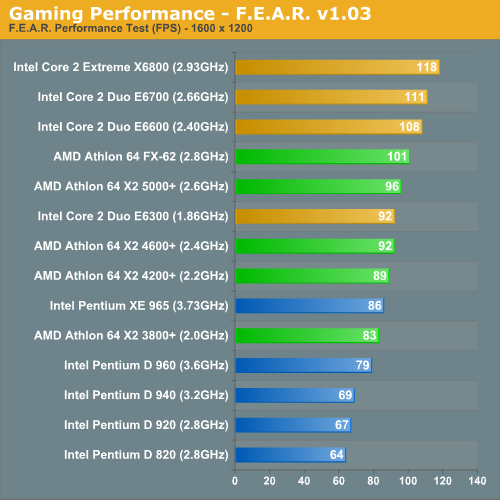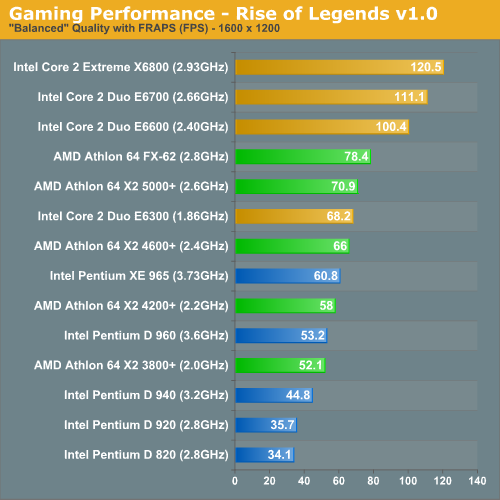Intel's Core 2 Extreme & Core 2 Duo: The Empire Strikes Back
by Anand Lal Shimpi on July 14, 2006 12:00 AM EST- Posted in
- CPUs
Gaming Performance using F.E.A.R. & Rise of Legends
Our F.E.A.R. test should be fairly familiar by now, as it is the built in performance test included with the game. Computer settings were left at "Maximum" while the graphics settings were set to "High" with the resolution cranked up to 1600 x 1200. F.E.A.R. ends up still being more GPU than CPU bound at these settings, even with a pair of X1900 XTs at its disposal, but we do see some separation among the processors:

The top three spots still go to the top three Core 2 CPUs, with the E6300 falling around the level of the X2 4600+. A trend that we've been seeing all throughout this review is that the performance of these CPUs effectively falls into three groups: Core 2 processors at the top, Athlon 64 X2s in the middle and Pentium D at the very bottom of the charts. In a sense that's the easiest way to classify these three groups of processors: if you want the fastest it's Core 2, mid-range goes to the Athlon 64 X2 and if you don't like good performance there's always the Pentium D.
Rise of Legends is a newcomer to our game benchmark suite and what an excellent addition it is. This Real Time Strategy game looks very good and plays well too; it serves as good filler until the next Command & Conquer title eventually arrives for those looking for a RTS fix. We ran with the resolution set to 1600 x 1200 and the graphics settings set to the medium defaults. We recorded a custom playback of a 3 vs. 2 multiplayer battle and played it back at 4x speed, recording the average frame rate for 10 minutes of the battle. The 10 minutes we focused on contained a good mix of light skirmishes between opponents, base/resource management with very few characters on the screen and of course some very large scale battles.

As with most RTSes, Rise of Legends is extremely CPU bound. The performance variability between runs was fairly high in this test, mainly because of how disk intensive the playback can get. Differences in performance of up to 5% should be ignored, but the standings are correct - the Core 2 line of processors absolutely demolish the competition: you're looking at true next-generation CPU performance here. The E6300 isn't nearly as impressive when compared to its more expensive siblings, but when you compare it to AMD's lineup it looks very good, especially considering its proposed cost.










202 Comments
View All Comments
soydios - Friday, July 14, 2006 - link
Awesome article, as always from AT. Between the article and the 100+ comments above this one, almost all my Conroe questions have been answered.;)
johnsonx - Friday, July 14, 2006 - link
Wow is all I can say. I don't think there's ever been a performance jump quite like this. AMD will still do ok (not win mind you) on the low-end, where most people live, but the mid-range and high-end is so overwhelmingly in Intel's camp now there's just no comparison. AMD would have to go to 3.4Ghz+ to even be competitive (and still not win mind you).My office computers will continue to be AMD Sempron for the forseeable future (AM2 from now on of course), but next time someone wants a CAD box I don't see how I can quote anything but Core 2 Duo.
Also, loved the dinner table analogy on page 13.
crimson117 - Friday, July 14, 2006 - link
http://www.tgdaily.com/2006/07/13/dell_xps700_to_f...">http://www.tgdaily.com/2006/07/13/dell_xps700_to_f..."Grapevine (TX) - On the day Intel announces its next generation of Conroe desktop processors - which is expected within days - Dell Computer will upgrade its top-of-the-line XPS 700 desktop computer model to offer not only an overclocked Core 2 Extreme CPU, but also the option of two Nvidia GeForce 7900 GTX cards in SLI mode. These will apparently replace the Pentium Extreme processor and GeForce 7900 GS options currently available, and will be in addition to the Aegia PhysX accelerator already offered."
epsilonparadox - Friday, July 14, 2006 - link
Probably an Nf4 chipset since there are motherboards with conroe support using Nf4.Avalon - Friday, July 14, 2006 - link
This is one fine architecture. It wound up performing as well as I had suspected it would. Definitely wow.cgrecu77 - Friday, July 14, 2006 - link
I gambled by purchasing a A64 3700+ a few weeks ago when it dropped to under 150 ...If I were to upgrade to the cheapest solo I would probably have to pay 500 dollars or more (new cpu, mb and memory) and I will probably get ~ performance in games. I stopped overclokcing a long time ago (except for maybe 10%) because I am tired of my new system becoming unstable after 4 months (plus I don't really need it anymore since nothing I do is really cpu limited).
98% of people actually buy the cheapest CPUs in a range (A64 2800-3200, x2 3800, C6300). That's where the real competition will be and frankly I'm not impressed at all, A64 is an ~3years old processor and intel's newest product can only beat it by 20%? As far as I can remember the Athlon 3200+ was even worse in comparison to P4 3,2 Ghz and most people still bought the 2500+ Bartons ... So I wouldn't worry too much if I were an AMD stock holder, especially that it looks like Opterons still have no competition in the multi cpu servers (more than 2 ...).
After all, if Dell decided to use AMD NOW of all times it must mean something, they probably had access to these benchmarks a little earlier than Anand had ... :)
One thing I would have expected to see for such a new CPU that is supposed to carry the Intel flag for the next 2 years is 64 bit performance. This is probably the last year when 32bit OSes have the upper hand, starting with Vista most people will take advantage of their 64bit cpus. Once the majors concentrate on 64 bit drivers you can be sure that they will gradually take resource from the 32 bit development and the balance will shift very quickly ... If A64 has even a 10% advantage over the Cores combined with the .65 switch it will probably balance the equation to the point where core and a64 will have similar performance per clock ...
dargaard - Saturday, July 15, 2006 - link
http://babelfish.altavista.com/babelfish/trurl_pag...">Some Conroe problems (??) with 64 bitdev0lution - Friday, July 14, 2006 - link
First off, why mention Core Solo when it's totally unrelated to this article and any of the comments?
Second, socket 939's days are already numbered. You'd have to pay the same $500 to upgrade to the AM2 processors benched in the article, so mentioning this as a diss to Core 2 Duo is pretty weak.
So you'd have the option of spending $500 to upgrade to a E6600 setup that would beat out a $1200+ AM2 setup. Sounds like a no-brainer. And if you think AMD's going to slash prices below Intel's parts I don't think you can hold your breath that long.
And 98% of people don't even build their own computers, they buy tier-1... who aren't making nearly that percentage of their systems with the lowest end parts.
Looks like I'll have a 3200, 3700 and 4000 (939 parts) for sale in the near future...
MrKaz - Monday, July 17, 2006 - link
OK.But if you dont want to spent more than 120$ for the processor, the Conroe looks expensive.
aznskickass - Friday, July 14, 2006 - link
Dude, 20% is a HUGE margin when you are talking competitive benchmarks.When A64 was released back in 2003 it had about a 10% edge on the P4 and people were lauding it for it's leap in performance, and rightly so, considering the AXPs were getting beaten by 10%, so it was a 20% turnaround altogether.
This time around, it's even more impressive from Intel as they have turned a 10 - 20% performance deficit into a 20% advantage, you really can't expect much more than that, can you?
What did you expect Intel to do, double A64 performance? I'm sure if they ran their chips @ 4GHz/400FSB they might be able to get close to that, but what is the point when you have beaten your competition so convincingly already?